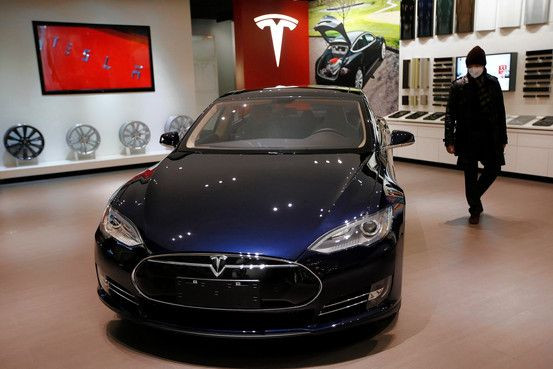Tesla First Quarter Earnings: Five Things To Look For

Tesla Motors Inc. (NASDAQ:TSLA) has emerged as the first luxury-level electric sedan maker with the potential to move beyond boutique-automaker and become the world’s only mass-producer of exclusively all-electric vehicles. After markets close in New York on Wednesday, the world will see how much closer the Fremont, California, company has gotten toward that goal.
The maker of the Model S luxury electric car is expected to report higher revenue and gross margins, but lower net income, as the company has expanded its global reach over the past year. Analysts polled by Thomson Reuters forecast that Tesla has attracted $699 million in revenue, up 24 percent from the same quarter last year, and netted $13 million in profit, or 10 cents per share. Adjusted for one-time costs, the EPS is expected to be a loss of 18 cents.
Tesla’s stock has been driven up nearly 208 percent over the past year thanks to investors’ appetite for the company’s future potential. Though the automaker has only delivered one positive-growth quarter (based on fully reported earnings per share), the stock has leaped from just over $55 a year ago to a 52-week high of $265 in early March. Since then, there’s been a much-needed correction with the stock settling on Tuesday at $207.15. Wednesday’s report will give an indication of where the stock is headed into the summer.
Here are five important things to look out for in Wednesday’s earnings report.
1) Where will the gigafactory be built and who will help Tesla pay for it? The company said it’s planning to build a 10-million-square foot factory at a cost of up to $5 billion to produce enough lithium-ion cells to support production of 500,000 electric cars a year. Tesla sold $2 billion in convertible bonds in February that were quickly snatched up mostly by institutional investors. The automaker needs partners, and a location. Panasonic Corp. (TYO:6752), which currently makes and supplies the cells for the Model S, and Daimler AG (ETR:DAI), which owns a small stake in Tesla and uses the company’s electric drive, have publicly expressed hesitancy about becoming partners in the deal. Any guidance on when (of not how or where) the company expects to move forward on the project would be significant.
2) In mainland China, Tesla opened its retail operations, delivered its first Model S car and opened its first Supercharger quick-charge station. To underscore China’s importance to Telsa’s global strategy, CEO Elon Musk handed the key to the first mainlander to buy one of his cars. The Chinese government wants 5 million electric cars on its roads by 2020 in order to reduce smog and dependence on foreign oil. Tesla might outline its progress in fleshing out its charger network and plans to open a manufacturing facility in the world’s biggest single market for luxury cars. Plans to manufacture the Model S (and future Telsa cars) in China would not only bring the $122,000 Model S starting price down but also might encourage China to extend any incentives it offers to domestic electric car manufacturers to the California carmaker. Tesla’s current largest market outside of the U.S. is Norway, whose generous green-vehicle incentives have helped Tesla. Reproducing a similar advantage in China would be good news.
3) How is the company progressing in manufacturing and sales growth? The company has said it plans to deliver 35,000 units this year, up from 22,500 in 2013, the first year the 10-year-old company has expanded globally. It currently produces 600 cars a week from its Fremont plant. Look for any increase in this number. The company says it would be making 1,000 cars a week by the end of the year. The company will likely provide more details about the upcoming Model X crossover, which is supposed to begin production in early 2015. If Tesla follows a typical product cycle of an auto manufacturer, it will be due for fresh product by then. Any delays in Model X production would be a red flag. The lower-cost Gen III is due out by 2017. The $35,000 to $40,000 smaller Tesla should expand the company’s consumer base, but few details have been provided, especially regarding the vehicle’s range compared to the Model S. A cheaper Tesla would expand the company’s consumer base at the cost of profit margin. But a $40,000 electric vehicle with a range of at least 100 miles would be better than any current lower-cost EV on the market. The sooner a Tesla like that comes out, the better for the company, because competing automakers are also aiming for a Gen III-type vehicle.
4) Gross margin must stay above 25 percent and preferably higher than the 24.9 percent announced in the fourth quarter. In the first quarter of last year, the gross margin was 17.4 percent. Tesla says it can get to 28 percent by the end of the year. Achieving that will be harder if the company reports flat or lower gross margins compared to the fourth quarter.
5) Cost of expansion. Look for capital and administrative costs increases. Look for guidance on when the company expects these costs to decline. There are currently 76 Superchargers in North America, which allows Tesla car owners to charge their cars for free, but there's still a long way to go and a lot to spend to get the full U.S. coverage. The company could provide details on its previously announced quick-swap option, where for a fee Model S owners will be able to quickly swap batteries at some Supercharger stations. Any further information on expansion costs and how they might impact future earnings and margins will be important.
© Copyright IBTimes 2024. All rights reserved.






















